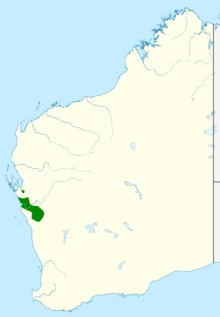
Back بنكسية صولجانية Arabic Banksia sceptrum Azerbaijani Banksia sceptrum CEB Banksia sceptrum Spanish بانکسیا عصایی Persian Banksia sceptrum French Banksia sceptrum Italian Banksia sceptrum Russian Banksia sceptrum Swedish Banksia sceptrum Vietnamese
| Sceptre banksia | |
|---|---|

| |
| Scientific classification | |
| Kingdom: | Plantae |
| Clade: | Tracheophytes |
| Clade: | Angiosperms |
| Clade: | Eudicots |
| Order: | Proteales |
| Family: | Proteaceae |
| Genus: | Banksia |
| Subgenus: | Banksia subg. Banksia |
| Section: | Banksia sect. Banksia |
| Series: | Banksia ser. Banksia |
| Species: | B. sceptrum
|
| Binomial name | |
| Banksia sceptrum | |

| |
| Range of Banksia sceptrum in green | |
| Synonyms | |
|
Sirmuellera sceptrum (Meisn.) Kuntze | |
Banksia sceptrum, commonly known as the sceptre banksia, is a plant that grows in Western Australia near the central west coast from Geraldton north through Kalbarri to Hamelin Pool. It extends inland almost to Mullewa. First collected and grown by early settler James Drummond in Western Australia, it was described by Swiss botanist Carl Meissner in 1855.
In nature, B. sceptrum grows in deep yellow or pale red sand in tall shrubland, commonly on dunes, being found as a shrub to 5 metres (16 ft) high, though often smaller in exposed areas. It is killed by fire and regenerates by seed, the woody follicles opening with fire. B. sceptrum is one of the most striking yellow-flowered banksias of all. Its tall bright yellow spikes, known as inflorescences, are terminal and well displayed. Flowering is in summer, mainly December and January, though flowers are occasionally seen at other times.
The common name 'sceptrum' is due to the prominent spiky bracts which resemble a ceremonial mace (a sceptre).
- ^ George, A.; Keighery, G.; Atkins, K. (2020). "Banksia sceptrum". IUCN Red List of Threatened Species. 2020: e.T112529775A113306781. doi:10.2305/IUCN.UK.2020-2.RLTS.T112529775A113306781.en. Retrieved 21 September 2021.
© MMXXIII Rich X Search. We shall prevail. All rights reserved. Rich X Search
